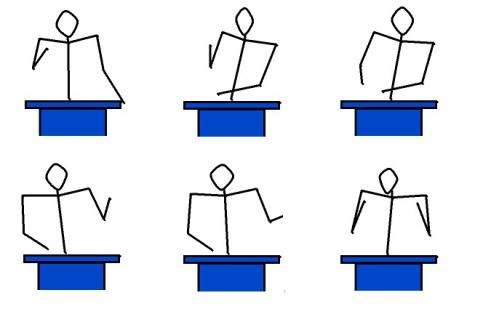Motion makes Opinion. The importance of body motion in the formation of opinions about politicians is now analysed in a new project.
A new research project analyses the importance of body motion in the formation of individual opinions about politicians. The aim of the project, which is funded by the FWF, is to identify movement patterns that play a key role in such opinion formation. A previously developed method enables the analysis of real politicians' movement patterns while simultaneously concealing their physical appearance. In this way it is possible to analyse other factors that influence opinion formation – for example, physical appearance and gender – separately from movement patterns.
Politics abounds with dynamic moments – not least when politicians jump up to speak and address the public using their entire bodies. The impression they make on such occasions is often formed less by the words they speak than by the non-verbal signals they transmit. This has been demonstrated scientifically. Such signals include their appearance, intonation, posture and movements. However, the extent to which these signals contribute to the opinion formed of politicians has not been widely studied up to now, particularly in relation to body motion. This gap in the research is now being filled by Dr. Markus Koppensteiner from the Department of Anthropology at the University of Vienna.
Every picture tells a story
In a recently launched project, which is funded by the FWF, test persons will assess the personalities of German politicians. The material, on which their assessments are based, will be provided by video recordings of speeches recorded under comparable conditions in the German Bundestag. The decision to select German – and relatively unknown – politicians for the experiment was a conscious one to avoid the interference of preconceived views on the part of the exclusively Austrian test participants.
However, as Dr. Koppensteiner explains, our opinions are not influenced by preconceived views alone: "The aim of my research study is to assess the contribution of movement patterns in isolation. To do this, other impressions like appearance, intonation and gender must be concealed – without altering the natural movement pattern. I developed a software programme for this purpose during my doctoral studies which enables the recording of motion sequences on the basis of video sequences." The software allows him to mark certain points on the body of the speaker using the computer mouse, trace their changes in position and, with the help of the stored data, reproduce the movements as simple "stick-figure" animations.
Moving speeches
Dr. Koppensteiner has already converted the 60 speeches by the German politicians into 15-second-long stick-figure "movies". These and the original videos will provide the basis for further research. This will involve the production of four different "mutations" of the video sequences, which enable the separation of verbal and non-verbal information. In this way, the original videos can be used with image and sound and with the image sequences alone. The other two mutations involve the use of the sound signals alone and the animations without sound. The latter version represents the complete reduction of the politicians' presentations to their motion sequences. Explaining the next step in the process, Dr. Koppensteiner says: "Four different groups will then assess the different sequences and state their opinions on the represented persons. For example, whether they appear competent or trustworthy to the participants."
These independent assessments enable the estimation of the relative contribution of movement patterns to the overall opinion formed of the politicians. For example, if the assessments of the original videos display a high level of agreement with those of the computer animations, it may be concluded that body movement has a significant influence on opinion formation.
Dr. Koppensteiner also plans to take his analysis one step further and introduce controlled manipulations into the sequences of movements made by the animated stick figures. This will enable him to test whether the exaggeration or reduction of certain movement patterns alters the opinion formed. This is an important way of controlling the insights obtained from the study, which also facilitates the targeted utilization of movement patterns for emphasising certain characteristics – and could, therefore, enable the practical application of the FWF project findings.
Provided by Austrian Science Fund (FWF)
























